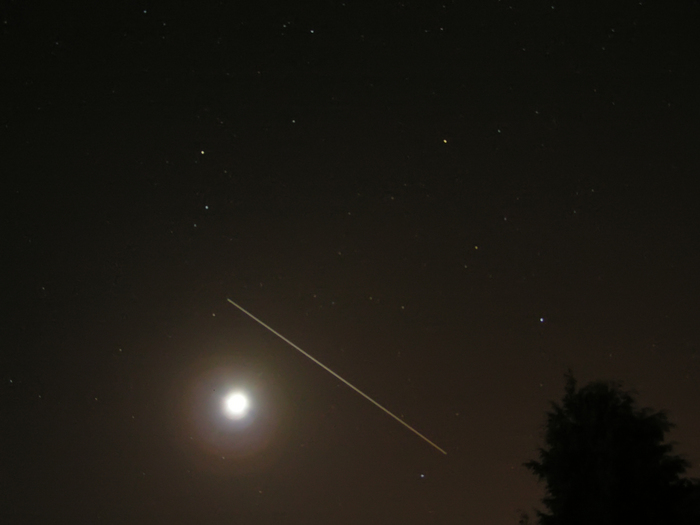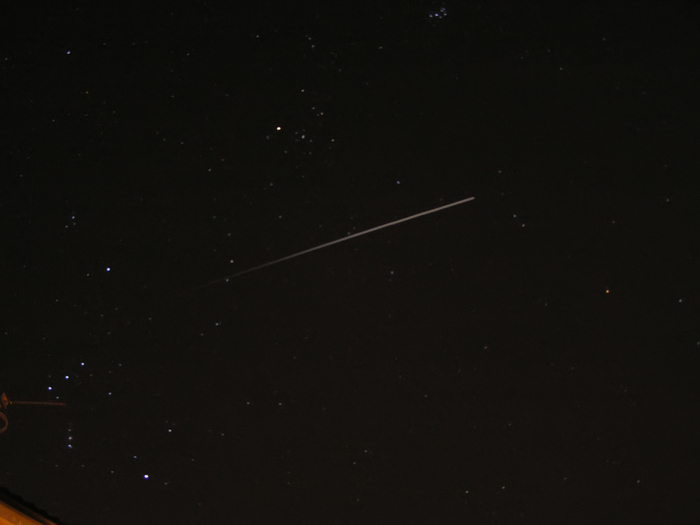This is truly unbelievable. In the words of a well known TV character "I Don't Believe It!!" Another clear and sparkly night. Well, I certainly wasn't going to argue that's for sure. After checking on Heavens above for the time of the ISS pass (due to pass very near the moon), I set up the camera and scope. Again with my youngest, I ducked outside at about 1845, aligned the camera up with the moon in the bottom of the frame (no need for an alignment shot in advance here) ready for the ISS to pass by the moon. I figured that whilst we waited, my boy could take a look at the moon through the scope. I dropped in the 5mm Ortho (80x) and lined up on the limb. Firstly, let me just say thanks to everyone that advised me to get the fringe killer. Oh boy does it make a real difference (a slight yellowish cast instead of all the blue/purple, but as it's all over the view and doesn't interfere in any way, it's not a problem).
My son thought looking at the moon was great, his description was superb. "It looks like someone's been biting at it". Quite apt I thought.
I'd spotted that there was another satellite Rosat due to pass a couple of minutes before the ISS, but it was much dimmer and I think too low down in the sky, we didn't see this one. Then the ISS flew past. We watched it climb the sky, looking dim and red when we first sighted it, low to the west, and climbing and brightening as it went. It past over the moon and faded out towards Orion. I managed to catch two shots of it on the camera.
ISS Leaps over the moon:
ISS fades into Orion, passing the Hyades and Pleiades:
I can't decide which of these two images I prefer. I like the first one, as it looks great, and the second one because of the unexpected backdrop.
After the ISS had passed, I swung the scope around to Orion, and then swung the bench around, that he was standing on to view the eyepiece. He was a little excited at this point, and kept jumping up and down on the bench, which as it was touching the scope tripod, kept jiggling the view, made it kinda hard to line up and focus. We saw M42 and three of the Trapezium stars, then tried to show him the Castor main double, my scope is too small for the third. Then we had a look at Mars, as it was there lurking above us. No change in my little scope, a very small orange/red disk. But that's ok. Then it was time to go in for a while.
Time passed, 2 hours to be precise. I'd decided that tonight I'd try and find the clusters around Cassiopeia. What I hadn't realised before I started was just how many there were, nor in the time it took me how close to the trees Cassi was going to get.
I started out at the highest point, and worked my way down. This was probably a mistake as will be seen shortly. I started by finding Kembles Cascade. I'd seen this before in Bins, but decided I'd have a go with the scope. The FOV is smaller about half, using the Hyperion, so I couldn't see all of the cascade, but with a small nudge, was able to find the rest. I counted the stars in the cascade and could see 15. There were others, nearly lined up with the cascade, that were brighter, but I'm not certain whether or not they are part of the cascade, so didn't count them. The cascade emptied into the pool of NGC1502, which I thought I'd try and sketch. Here's my big mistake for the night. Don't try and sketch using a biro on lined paper under red light. It just doesn't work very well, and I'm not sure I could translate my sketch into something anyone would want to see. I will give this another go at some point, and use pencil on plain paper.
Moving on downwards, well actually, going back to Cassi and hopping outwards again, but it'll get a little dull if I put down all the instructions. I found SU/RZ Cass. I didn't hand around long enough to observe any changes in these stars, it's something else I will go back to and spend some time on at a future point, but tonights objective was finding clusters. So onwards. I found NGC559 then moved onto NGC663 and M103. I got myself confused around here. In the Hyperion the FOV was just about large enough to cover both in one go, not a problem I'd anticipated, but it meant that I kept bumping into the Perseus double, and on one of these occasions, I'm pretty sure I found Stock 2. Anyway. it took me about 10 minutes to work out what was going on, odd that it took me that long, but I was engrossed in what I was looking at. I found NGC654 and NGC659, whilst in the same area, but they were really tough to spot, nothing to see here in that little scope, move along, either call me persistent or stupid, I worked at it anyway, and I'm pretty certain I got them.
Then onto NGC457, this looked quite pretty, (note to self, write a short description of what can be seen when something is found) if I remember correctly, this was a small double line of stars. Of course, I can't really remember and that might be a different cluster oops. I managed to pick up NGC436 nearby too. Then onto NGC637, although if I'm honest,I might have found NGC559.
I managed to muddle myself up here, and went in the wrong direction to find NGC225, and couldn't figure out why the small pic in TL@O was different from what I was looking. It took me 10 minutes of puzzling to realise what I'd done wrong and that actually I was looking at NGC129. Ho hum, still, mistakes are a good teaching/learning tool. Gotta remember to follow the instructions more carefully. I then worked out the correct directions and found NGC225. Then on to M52 again (I'd seen this the other night, but figured I'd hunt it up again for completeness). It was now I realised my mistake in starting at the highest point and working downwards. In trying to find NGC7789 I found it was lurking and playing hide and seek in amongst the branches of the trees at the end of the gardens. Ah phooey. Gonna have to try this one again another night.
I turned the page in TL@O and discovered that I'd reached the end. Excellent, nearly all of them. As Ursa Major was getting higher up in the sky now, and hopefully pulling out of the Gatwick glow, I thought I'd have another try and a galaxy hunt (sticking to the higher ones). I tracked up from Phecda, through Dubhe to the location of M81 and M82. Hmm, thought I, these are supposed to be here, are they in hiding ? After some careful viewing, and a little jiggling, I found them as 2 very faint smudges. This isn't good thought I, given that M81 should be visible in Bins (according to NW). I thought I'd have a go at a couple of others, M108 and M106, but no chance, these are both dimmer than M81 and M82 and both a bit lower down. I think the limit to the north from here is about Mag 8.
Ah well. Gonna have to give up on hunting for Galactic smudges for a while, but that's ok, there's still loads of other things to see. And one of the most stunning, was just pocking her head above the roof of the house. I looked up and there was the question mark of Leo. Drifting serenely below that, Saturn. Excellent, thought I and bought the scope to bear. I stayed here for a fair while, definitely saw two moons (Rhea and Titan), possibly a third, although I can't be sure on that one, but if I did it was Tethys.
Then, realised, I hadn't eaten anything since lunchtime and as it was now nearly 2300 I was a little peckish, so I finished the session off with the usual Favs. The Sisters and The Beehive.
Lessons learned:
1) Write a brief description of what is seen
2) For a sketch use a soft pencil
3) Follow the instructions properly (you'd think I'd have learnt this one by now)
A most enjoyable evenings viewing.
Tuesday, 12 February 2008
ISS Again.... Undressing Cassiopeia - Feb 11th
Subscribe to:
Post Comments (Atom)







No comments:
Post a Comment